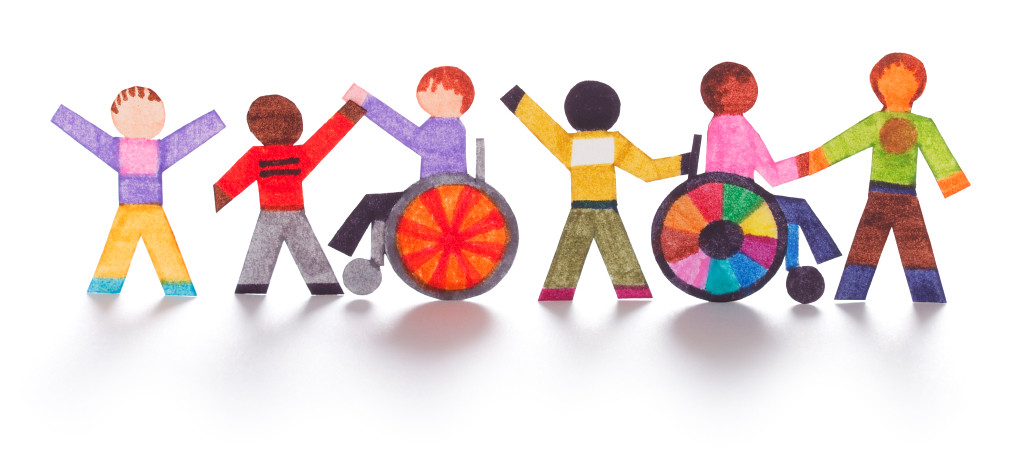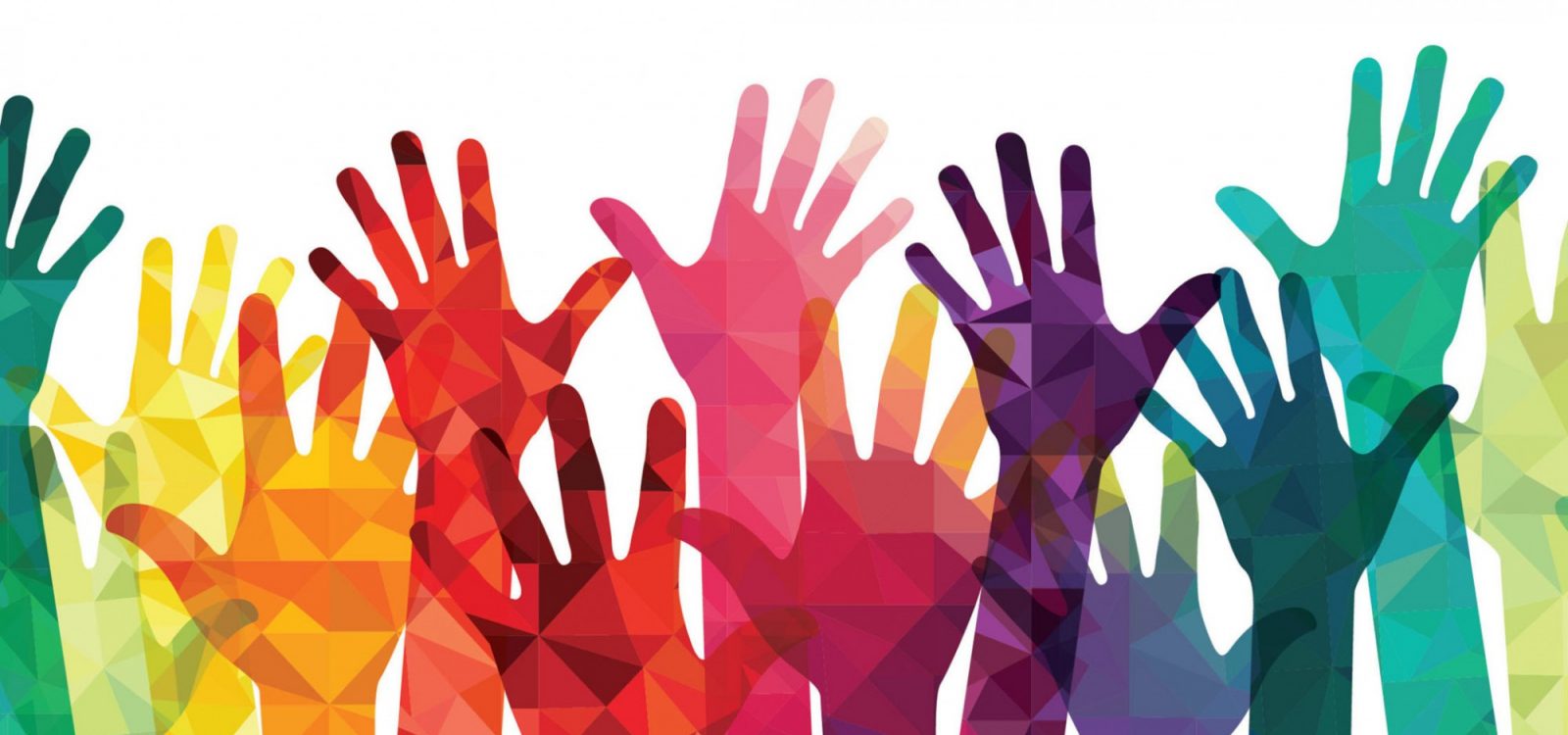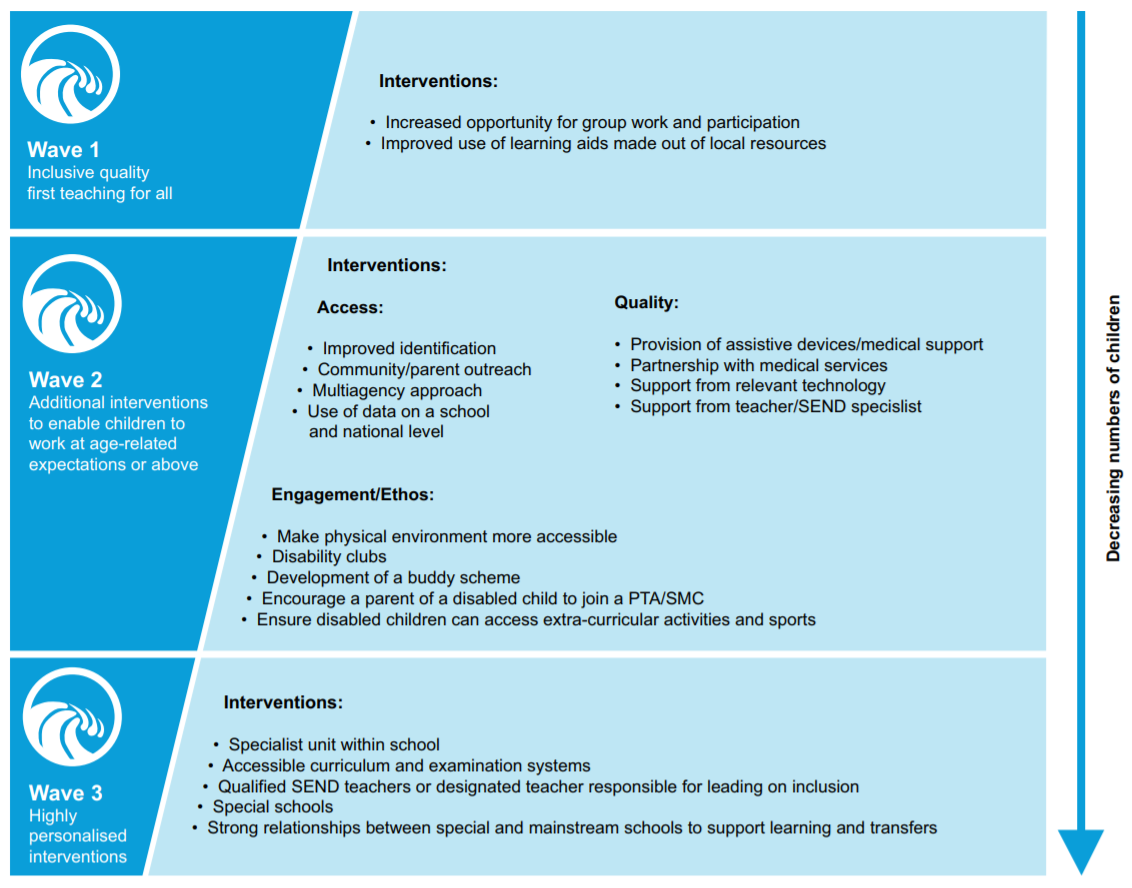Week 1: Thinking about inclusive education
| Site: | OpenLearn Create |
| Course: | Inclusive Teaching and Learning |
| Book: | Week 1: Thinking about inclusive education |
| Printed by: | Guest user |
| Date: | Tuesday, 2 December 2025, 4:04 PM |
Table of contents
- 1. Introduction to this course
- 2. Introduction to Week 1
- 3. What does it mean to be excluded?
- 4. What does it mean to be included?
- 5. A model for thinking about inclusive education
- 6. Inclusive principles in practice
- 7. A vision for inclusive education
- 8. Understanding inclusive education
- 9. Looking forward
1. Introduction to this course

Inclusive teaching and learning and Creating an inclusive school are two, four-week courses brought to you by the Commonwealth of Learning working in partnership with The Open University‘s UK Teacher Education in Sub-Saharan Africa (TESSA) team. This first course, Inclusive teaching and learning, focuses on what it means to be an inclusive teacher. The underlying assumption is that inclusive teaching is the responsibility of all teachers, not just those with special training, and that all teachers and teaching staff have a responsibility to develop and use inclusive practices. This course will benefit all leaners, including those with special educational needs.
In Week 1, the focus is on who is in danger of being excluded, and how we can think about the issue. In Week 2, you will examine why the attitudes and values of learner-centred education are an appropriate policy response to calls for a more inclusive system and discover tools to analyse teaching from a learner-centred perspective. In Week 3, you will examine what inclusive teaching looks like in practice and some of the practical teaching approaches that can be used to involve all learners. In Week 4 the focus is on how to bring about change. It introduces the idea of a teachers’ ‘toolkit’ to support your ongoing inclusive teaching and looks in more detail at open educational resources and the role of reflective practice in bringing about change. Finally you will look ahead to the next MOOC which will focus on developing an inclusive school.
2. Introduction to Week 1
We all learn best when we feel safe, valued and included. When children experience inclusive education, they can reach their full potential and become valued participants in society. When parents know that their children are treated fairly and have the opportunity to thrive in school they are more likely to support their learning and ensure that their child attends school. However, families of children with disabilities are often worried that their children will not be valued and included in the classroom. This means that many children with disabilities are not attending school. These children are at risk of not completing their basic education and missing out on the learning needed to take on a full role in society and become financially independent adults. They are also in danger of being socially excluded if they do not form friendships and become part of their local community (Sarton and Smith 2018; UNICEF 2020).
This first course will help you to find ways to provide ‘inclusive education’ for all children, so that children with disabilities are able to learn alongside their peers.
UNICEF (2020) offers a simple definition of inclusive education:
Inclusive education means all children in the same classrooms, in the same schools. It means real learning opportunities for groups who have traditionally been excluded – not only children with disabilities, but speakers of minority languages too.
(UNICEF 2020)
Week 1 of this course will help you to reflect on your existing ideas about inclusive education and what it means to be inclusive. You will think about why some children may feel excluded and how all teachers can develop inclusive strategies to benefit all children.
In this first week you will:
- reflect on what it means to feel excluded and compare this with being included
- engage with a model for inclusive education and what it means to be inclusive
- consider strategies to support active learning and teaching.
In total there are seven activities in this first week, including a quiz at the end that is part of your course assessment.
2.1. Activities for the week
|
Activity number |
Title |
Details |
Time |
|
1.1 |
Feeling excluded |
Reflect on times when you have felt excluded and which students you know might feel excluded and why. |
30 minutes |
|
1.2 |
Feeling included |
Consider times when people have deliberately included you |
10 minutes |
|
1.3 |
Experiences of exclusion and inclusion in education |
Listen to a film and read a blog about how people were included. |
20 minutes |
|
1.4 |
Introduction to the Waves Intervention model |
Watch a slidecast about the Waves model |
10 minutes |
|
1.5 |
What does the Waves Intervention model mean for you? |
Read an article explaining the Waves model in more depth |
1 hour |
|
1.6 |
Involving all |
Watch two film clips and notice how the teacher involves all students |
20 mins |
|
1.7 |
Inclusive principles in practice |
Analyse a case study and reflect on your experiences this week |
30 mins |
|
1.8 |
A vision for inclusive education |
Daniel reflecting on a vision for inclusive education |
15 mins |
|
1.9 |
Week 1 quiz |
|
|
3. What does it mean to be excluded?
We can all be excluded at different times in our lives. This may be because we are new to a situation or are in some way different to the majority group of people we are interacting with. Sometimes we might be excluded by a lack of shared understanding or language. Even an environment or resources can exclude us if we don’t know how to use them. Being excluded can limit our opportunities to learn or participate. It can also affect the way that we feel about a situation and can damage our confidence and motivation.
Understanding why children feel excluded can help us to think about ways to include them. Children with disabilities are at greater risk of exclusion. They may be socially excluded because their disabilities are obvious to others and people treat them differently. However, some disabilities are hidden, and these children may be excluded because people are unaware of the adaptations they need to help them access learning.
Children with disabilities are especially at risk of being excluded from reaching their potential and participating in society (Worldbank 2020). Children with disabilities can be defined as:
… those who have long-term physical, mental, intellectual or sensory impairments which in interaction with various barriers may hinder their full and effective participation in society on an equal basis with others.
(UN, 2006)
Many children with disabilities may not attend school, but those who do may also feel excluded whilst attending school if their needs are not taken into account. Overcoming exclusion is important because:
education is the gateway to children’s full participation in society – transition into adulthood, opportunities for employment, and engagement with their communities.
(UNICEF 2018).
|
Reflection point Who do you think of when you hear about a child with disabilities? What kind of impairments might be hidden or invisible? |
Most people have felt excluded or ‘left out’ at some point in their lives. This could be as obvious as being unable to enter a building or not being allowed to join in with an activity. It could also be much less obvious, such as feeling excluded because you do not understand all the words that are being used in a conversation. The first activity asks you to think about any experience you may have of being excluded and what factors contributed to this.
3.1. Who might be excluded?
Activity 1.1 Feeling excludedAllow approximately 30 minutes for this activity
Share an example on the Week 1 forum and read at least two other posts.
Now think about the children in your class:
Now compare what you have found –are there any common reasons for children and adults to feel excluded? Finally, on your mind map group the different reasons for feeling excluded into categories such as a physical, academic or social. |
|
Examples from practitioners
|
Children may be excluded if they have disabilities, but also because of features of their everyday lives. This course will help you to think about how to overcome these reasons for exclusion in the classroom in order to include everyone, by considering practice and how to improve it, and attitudes and how to challenge them.
4. What does it mean to be included?
Being included can involve the way people speak to you, their gestures and body language and how they help you with tasks. Being included can allow children to feel valued and capable of learning. If children are in an environment where they are encouraged to persevere, even when things go wrong, they may develop a ‘growth mindset’. A growth mindset is a self-belief that someone can learn and achieve. This positive attitude towards perseverance in the face of learning challenges has a significant impact on children’s educational achievement (Claro, Paunesku and Dweck, 2016). In this section we will start to think about simple ways that can help adults and children to feel included and able to achieve.
Activity 1.2 Feeling includedAllow approximately 10 minutes for this activity. Look back at your mind map for Activity 1.1:
Now think about the children in your class who might be excluded and make a note of:
|
4.1. Being included
Figure 1 An inclusive classroom.
You may have noted that when you were included perhaps people spoke to you differently, asked you questions about yourself or were genuinely interested in your ideas. People may have moved or offered you a place to sit so you felt part of group. Perhaps they explained something to you that you did not understand or helped you with a task which you found difficult. To feel included, you may have thought about feeling safe, valued and accepted.
The importance of being valued was highlighted in research with young autistic pupils:
They defined inclusion as belonging, being valued and wanted as a person by teachers, of fairness and of being afforded the necessary support to access and thrive in education. In short, inclusion is a feeling (a sense of belonging), not a place (mainstream or otherwise) (Goodall, 2020).
In all the examples from practitioners, you will have noticed that there were many ways in which people could have been made to feel included, such as:
- Someone noticing that there was a problem
- Teachers or peers providing a few kind words
- Teachers checking for understanding and adjusting their teaching to provide more support or more of a challenge
- Teachers organising the classroom so that learners can provide peer support.
You will learn more about what teachers can do to support inclusion in Weeks 2 and 3.
Now we have thought about what it means to be excluded and included, we will consider two examples of experiences in education.
4.2. Experiences of exclusion and inclusion in education
Activity 1.3 Experiences of exclusion and inclusion in educationAllow approximately 20 minutes for this activity. Watch and listen to the first minute of Frederik Haga from the Kenyan Ministry of Education talking about the new education policy for inclusion in Kenya. He explains his own experience of exclusion from the education system. Once you’ve done this, respond to the question below in your study notebook.
Now read the blog below about Senzo. Senzo was described as having a barrier to learning, but he was included through some simple adjustments to teaching. http://www.included.org.za/news/barriers-learning/
|
4.3. Whose responsibility?
In the case of Senzo, an observant and caring teacher made a difference; for Frederik, he needed specialist support, but there were still things that classroom teachers could have done to help him.
Frederik explains that there was limited understanding of how to help him to carry on with education when he lost his sight. He says that everyone thought he had to leave school and that his life changed completely. Frederik might have felt included if teachers knew more about how to support him, but also if wider social attitudes expected him to be able to stay in school. This demonstrates the importance of policy in bringing about change. You will consider policy in more detail in Week 2.
Fredrik could have been supported through the use of Braille and audio material. But if these were not available, then teachers could have used strategies like reading aloud, or organising pair work or group work in which Fredrik could have contributed to the discussions and been supported by his peers.
Often perceived barriers for children with disabilities may stem from wider social issues or negative views in society. However, children without disabilities in your class could also be excluded for other reasons. Teachers can address these through some simple adaptations to their teaching practices which will be shared in the following weeks.
5. A model for thinking about inclusive education
You may have some worries or reservations about inclusive education. You may expect that it requires specialist teachers, extra equipment or a different school environment. Thinking about inclusive practice at three different theoretical levels (or ‘waves’) offers a way for all teachers to understand what they can do to include all children. We will be using the model introduced in Activity 1.4 to help you to think about inclusive practice throughout this course.
The ‘Wave model of intervention’ (Sarton and Smith 2018) proposes that the first level (‘wave’) toward good inclusive practice is ensuring that all teachers are teaching to as high a standard as possible, using well-founded pedagogical principles, including differentiating work to cater for a variety of needs. Activity 1.4 below will help you familiarise yourself with this theoretical model.
Activity 1.4 Introduction to the Wave model of interventionAllow approximately 10 minutes for this activity.
This slide cast summarises the ‘Wave model of intervention’ as a way of thinking about inclusive education from Sarton and Smith.
|
5.1. The Wave model of intervention
In this model, inclusive education (IE) is seen as a ‘graduated response’ and is the responsibility of all teachers. Think of IE as three levels of intervention. The model proposes that the first level toward good inclusive practice is ensuring that all teachers are teaching to as high a standard as possible using well-founded pedagogical principles, including differentiating work to cater for a variety of needs.
If you encounter a learner with significant needs (e.g. someone who is visually impaired, or physically disabled) there will still be things that you can do in your classroom to support them, even if you need assistance to do so. The aim of this course is to ensure all teachers have the confidence to try and cater for the needs of all children in their classes.
Now you have been introduced to the Wave model of intervention, the next activity asks you to read about it in more detail and to begin to think about how it relates to your own practice. As you read, think about the reasons for being excluded you included in your mind map in Activity 1.1.
5.2. Focus on the Wave model of intervention
Activity 1.5 What does the Wave model of intervention mean for you?Allow approximately 1 hour for this activity.
Figure 2 Sarton and Smith’s three-level Wave model of intervention. View PDF version Page 2: Are you familiar with the definitions of inclusion and disability the authors give? Is there anything you would add? Pages 3 and 4: How do the ‘3 waves of intervention’ link to ‘universal’, ‘targeted’ and ‘specialist’ provision? Pages 5 and 6: When/how could you make more use of group or paired work in your lessons? What sort of learning aids could you provide? Pages 7 and 8: What are the differences between Wave 1 and Wave 2 intervention? Page 9 to 11: What are the challenges of Wave 3? What changes are needed to make the Wave model work?
|
5.3. Inclusive teaching in action
The three waves of intervention happen alongside each other as they are needed. According to the Wave model, any teacher can provide opportunities for all their pupils to be included in learning. This ‘universal’ provision may include developing ways for pupils to work together in pairs and groups. It might involve using pictures and objects to help children to understand new ideas or planning different tasks that the child can achieve. It does not require specialist training, but the teacher will need to think about new ways that the child can participate and learn. Wave 2 focuses on whole school approaches and partnerships, while in Wave 3, working with specialists is the focal point to support children who need it. You can learn more about providing all the Waves of intervention in the second course in this programme, Creating an inclusive school. The focus for this course is ‘Wave 1’.
Activity 1.6 Involving allAllow approximately 20 mins for this activity.
|
|
Reflection point Think again about children in your class who might be excluded in some way. How might some of the teaching strategies identified in the Wave model and the video help them to be included? |
6. Inclusive principles in practice
Now that you have thought about your experiences, and are now familiar with the Wave model, we will turn to look at the international principles of why inclusion matters. This way of thinking about inclusion sees equal access to education, opportunities to fully participate in society and treatment with respect and dignity as essential rights for all people. Including all children is an important contribution to meeting the Sustainable Development Goals (SDGs) of healthy lives, well-being and education.
The United Nations Convention on the Rights of Persons with Disabilities (CRPD) (2006) set out 8 guiding principles:
- Respect for inherent dignity, individual autonomy including the freedom to make one’s own choices, and independence of persons
- Non-discrimination
- Full and effective participation and inclusion in society
- Respect for difference and acceptance of persons with disabilities as part of human diversity and humanity
- Equality of opportunity
- Accessibility
- Equality between men and women
- Respect for the evolving capacities of children with disabilities and respect for the right of children with disabilities to preserve their identities.
Inclusive education draws on these principles by ensuring that all children feel valued and included and adaptations are made to support their learning. In the next activity, we will be asking you to reflect on how this course demonstrates inclusive principles for your learning experience.
Activity 1.7 Inclusive principles in practiceAllow approximately 30 mins for this activity.
Post your thoughts on the Week 1 forum. |
6.1. Going further
In the case study, the Wave 1 interventions included: noticing, using large print, sitting at the front, a buddy system and more interactive teaching approaches. The Wave 2 interventions included thinking about how to pass on information about learners to other teachers, a collective effort to raise money for photocopying, and talking to Molly’s parents. The Wave 3 intervention involved a specialist teacher visiting the school to give advice and making sure Molly visited the doctor, so that she was known to people who could help her.
Optional activity
You might find it worthwhile to spend some time browsing the Inclusive Education area of the UNESCO website. Download and save any resources which might be helpful to you. https://en.unesco.org/themes/inclusion-in-education
7. A vision for inclusive education
In preparing this course, we asked practitioners what inclusive education meant to them. In the next activity you will listen to one contribution from KISE.
Activity 1.8 A vision for inclusive educationAllow approximately 15 mins for this activity. View transcript / Download PDF Listen to Daniel explaining his vision for inclusive teaching. In your study notebook, summarise the key points that he makes. From a student’s perspective, Daniel’s vision is inspiring. Imagine what it would be like to be treated in this way! For a classroom teacher, however, Daniel’s vision is daunting! However, don’t be discouraged. The message from this course is that attaining the vision takes time. In Week 2 you will be introduced to the idea of a continuum – a continuous line between the current situation and a vision such as the one set out by Daniel. The idea is that through small changes in practice it is possible to gradually move along the continuum, and over time make a considerable difference to many students. You will return to this vision in Week 4. |
8. Understanding inclusive education
Now you have reached the end of Week 1 you should have a good understanding of what it means to be excluded and included. You should know about one model for inclusive education and have thought about some ways in which classroom teachers can use active teaching and learning to include all children. Use this week’s quiz to check your understanding.
9. Looking forward
In the next week of this course you will be introduced to ‘learner-centred teaching’. Learner-centred education is a popular policy response to calls for more inclusive teaching and is underpinned by inclusive attitudes and values. You will examine what this means and the implications for your own teaching practice. You will also be able to plan how you might apply learner-centred teaching approaches in your own context.
References
Sarton, E. and Smith, M. (2018). The challenge of inclusion for children with disabilities – experiences and implementation in Eastern and Southern Africa Chapter 7 in Chakera, E. Tao, S. (Eds) (The UNICEF Think Piece Series: Innovative Thinking for complex Educational Challenges in the SDG4 Era. UNICEF Eastern and Southern Africa Regional Office, Nairobi. https://www.unicef.org/esa/sites/unicef.org.esa/files/2019-04/EducationThinkPieces_7_DisabilityInclusion.pdf (Accessed 12/02/2020)
Claro, S., Paunesku, D., & Dweck, C. (2016) ‘Growth mindset tempers the effects of poverty on academic achievement’, Proceedings of the National Academy of Sciences of the United States of America, 113(31), pp. 8664–8668. [Online]. Available at www.jstor.org/stable/26471021 (Accessed 7 July 2020).
Goodall, C. (2020) ‘Inclusion is a feeling, not a place: a qualitative study exploring autistic young people's conceptualisations of inclusion’, International journal of inclusive education, 24(12), pp. 1285–1310. doi: 10.1080/13603116.2018.1523475 (Accessed 11th January 2021).
Sarton, E. and Smith, M. (2018) The challenge of inclusion for children with disabilities – experiences of implementation in Eastern and Southern Africa [Online]. Available at https://blogs.unicef.org/blog/challenge-inclusion-children-with-disabilities/ (Accessed 7 January 2021).
UNICEF (2020) Inclusive education: every child has the right to quality education and learning [Online]. Available at https://www.unicef.org/education/inclusive-education (Accessed 7 January 2021).
UNICEF (2018) A welcoming classroom – all abilities one education [Online]. Available at https://blogs.unicef.org/blog/welcoming-classroom-all-abilities-one-education/ (Accessed 7 January 2021).
United Nations (2006) Convention on the rights of persons with disabilities [Online]. Available at https://www.un.org/development/desa/disabilities/convention-on-the-rights-of-persons-with-disabilities/article-1-purpose.html (Accessed 7 January 2021).
Worldbank (2020) Social inclusion [Online]. Available at https://www.worldbank.org/en/topic/social-inclusion (Accessed 7 January 2021)



